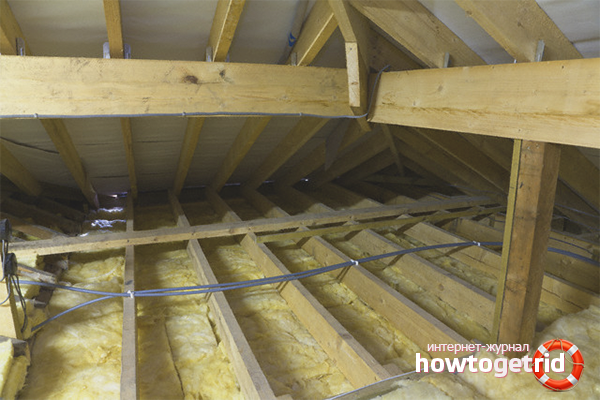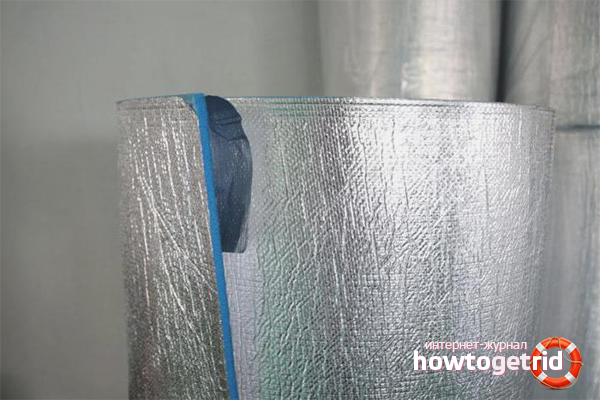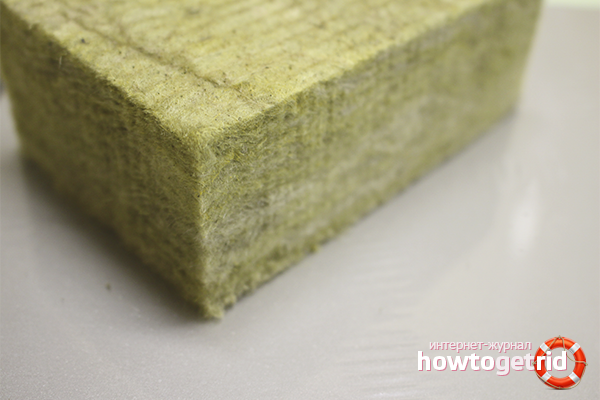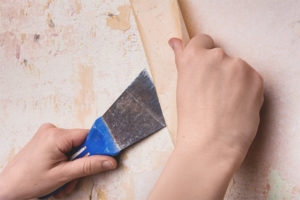The content of the article
The bath is a room with a special internal climate that needs to be maintained. The hot and humid air, rising, tends to go out through the ceiling. As a result, conditions during bath procedures become less comfortable.
To avoid this, you need to competently approach the solution of the problem. The article discusses in detail the stages of ceiling insulation in the bath. Describes various materials that will help to do the work.
The ceiling in the bath: types and materials
Wooden ceiling is better suited for bathing facilities. Wood endures air temperature drops, has a low thermal conductivity and has noise insulation properties.
There are three main types of ceilings:
- panel;
- hemmed
- grazing.
To create the ceiling using different types of wood:
- Pine;
- oak;
- aspen;
- Linden;
- cedar.
Installing the ceiling in the bath room, you can not use as a ceiling or inner lining, materials such as: hardboard, chipboard, plywood. They easily absorb moisture and deform.
Ceiling insulation methods
The design of ceilings is different, but the principle of warming remains unchanged. It should turn out to be a “pie” of three layers: a steam insulator, a heater, and a hydro insulator. Each layer consists of different types of materials. By combining suitable, you will be able to warm the ceiling well in the bath.
Insulation of the ceiling
The design consists of 40 mm thick roughing boards, which are laid on the wall trimming. Installation of the ceiling is carried out across the bath - by the shortest distance from one wall to another. Flooring ceiling is well suited for small rooms with a width of not more than 2.5 meters.
Instruction:
- Ceiling installation. Roughing boards 40 mm thick are laid on the wall trim. Then from the side of the room, bars are nailed to them with a step of 0.5 m.
- Laying insulation. A heat insulator is laid on the draft boards from the roof side. A layer of insulation should be at least 150 mm.Well plug the gap around the perimeter of the roof.
- Laying waterproofing. Stretch plastic wrap over the insulation and fix well. It will protect it from moisture, which can penetrate the roof.
- Laying the vapor barrier. Foil foils are often used for vapor barrier. She is nailed with a stapler to the ceiling from the side of the room.
- Installation of lining. First, the slats are attached to the bars with a thickness of 2 cm in increments of 0.5 m. This will ensure sufficient height for ventilation of the entire vapor barrier. Then to the rails nailed lining.
Flooring is done in saunas that do not have an attic. This type of overlap has weak strength and is not intended to be walked on. If your bath with an attic, but you decide to make a flat ceiling, try not to step on it. You can bend the boards, damage the protective layers of insulation.
Thermal insulation of the ceiling
It is considered the most simple and durable overlap, which is used in the baths with an attic. On it you can move freely and even store a whole warehouse of things. Podshivnoy ceiling suitable for large bath rooms. It consists of several parts:
- floor beams;
- headliner attic;
- headlining from the side of the room.
Instruction:
- Installation of vapor barrier. Steam insulation material is nailed to the ceiling beams on the side of the room. To do this, use the construction stapler and staples. Docking seams are glued together with tape.
- Installing crates. Across the beams nail the bars in increments of one meter. They serve as support for the vapor barrier and insulation.
- Ceiling installation. Edged boards are nailed to the crate - this will be the ceiling of the bath.
- Laying the insulator. The space between the beams in the attic is filled with insulation and tamped. The total height of the dense layer must be at least 150 mm.
- Laying waterproofing. Overlapping beams stretch the protective film, glue the joints with adhesive tape.
- Installation of attic floor. Sheathe the attic floor with rough boards that will protect the film from damage.
All layers of hemming ceiling keep beams, so high quality requirements are imposed on them.
Thermal insulation panel ceiling
This overlap consists of pre-fabricated shields (panels). It has a complex structure, which entails installation difficulties.For this reason, they are rarely used as a ceiling in the bath. Shields are knocked down on the ground, and then lifted and installed. In order for this to be easy to make them left empty. After installation, engaged in insulation.
The panel consists of the following elements:
- two bars;
- external boards (attic floor);
- internal boards (bath ceiling).
Instruction:
- Panel making. Select the timber length equal to the distance between the walls. Lay on a flat surface in parallel. The distance between them is one meter. Edged boards are nailed to the bars - this is the ceiling of the bath. This method is used to make all the panels, and then they are lifted to the roof.
- Laying the vapor barrier. The shields are covered with a vapor barrier film so that it fits tightly around the voids and bars.
- Laying the insulator. In the space between the bars stack 150 mm of insulation.
- Laying waterproofing. The cells of the panels, filled with insulation, covered with waterproof film and fixed with staples.
- Laying external boards. On top of the moisture-proof layer lay edged boards that will become the floor of the attic.
Warming around the chimney
A hot pipe is an increased source of fire, so it should not be warmed, since the entire ceiling. For the chimney fences are made in the form of boxes. Sand, claydite, clay, etc. are poured there. - everything that does not burn. This helps prevent the possible ignition of the ceiling insulation.
Materials for insulation of the ceiling in the bath
The construction market offers a variety of thermal insulation materials. Among them there are modern synthetic and natural. When buying insulation, consider the conditions in which they will be applied. Try to choose environmentally friendly and fireproof materials.
Steam insulators
Bath - a place with a high level of humidity. Steam, rising, strive to go out through the ceiling. Condensate is formed from the temperature drop, which causes rotting of floor boards and insulation. To prevent steam from escaping from the room and the appearance of moisture where it should not be, use different steam insulators.
Polyethylene film. It is an inexpensive material used as a vapor barrier.In order to create a reliable barrier out of it, it is necessary to qualitatively join the separate parts of the film. To do this, use special bonding tape.
This material has a number of significant flaws, making it not the best vapor barrier. The film quickly becomes outdated and loses strength. From frequent changes in temperature collapses. As a result, steam easily penetrates the insulation through cracks and holes.
Polypropylene film. Elastic film with increased resistance to tearing. It has good insulating properties, does not allow vapor and moisture, is resistant to high temperatures.
There are several varieties:
- transparent - the usual cheap film used for vapor barrier roofs.
- foil - has a metallized coating that effectively reflects steam and heat fluxes.
- membrane - a breathable material that can absorb moisture, and then slowly evaporate. Because of the complex composition has a high cost.
Liquid rubber. This material is used as a vapor barrier. Liquid rubber is a water-based polymer solution. After application, a transparent rubber film is formed on the surface that does not allow steam or moisture to pass through. This composition covers the floors, walls and ceiling.The monolithic layer of the film keeps well on the concrete and wooden surface.
Of all the above types of steam insulators, polypropylene films are often used: transparent and foil. They are cheap, durable and do a good job with the task.
Other materials: roofing felt, roofing sheet, glassine, cardboard, impregnated with linseed oil, wax paper.
Heaters
Thermal insulation of the ceiling is an important step in creating a good bath. When choosing a heater, it is necessary to take into account the properties that it should have: environmental friendliness and level of heat saving. The first criterion affects health, and the second at the time of preservation of heat. For insulation used various types of insulation.
- Mineral wool. No construction is complete without the use of this material. Insulation does not burn, long maintains heat in the room and easily fit. Mineral wool is afraid of moisture and very quickly comes into disrepair. During installation, it is necessary to isolate the insulation from water using a film. Attached to the surface with a special tape.
- Glass wool. Good insulation for the ceiling of the bath.Fire-resistant, not afraid of moisture, insects and mice do not live in it, it retains heat for a long time. The disadvantage of the material is increased fragility - the formation easily disperses into small fragments. Particles of fiber cause irritation, hitting the eyes, throat and skin.
- Penoplex. Modern insulating material in the form of plates. Light, does not burn, withstands sudden changes in temperature, fungi do not breed in it, mold does not grow. Penoplex retains heat in the bath for a long time and almost does not absorb moisture. The material is installed without waterproofing.
- Styrofoam. Often used in construction for the insulation of walls and ceilings. Especially useful in the bath room - does not absorb moisture and retains resistance to high temperatures. The disadvantage of foam is an increased fire hazard, so do not install near the chimney. Rodents like to make nests and holes in it.
- Penoizol. Liquid material that is used for sound insulation insulation. It is fed under pressure and fills all hard-to-reach voids. Penoizol is a breathable insulation. It absorbs moisture from the surface of the vapor barrier and waterproofing, prolonging their service life.The disadvantage of this material is low strength.
Other materials: expanded clay, sawdust, clay, straw, sand, a mixture of cement and sawdust.
Water insulators
Are the third final layer in the insulation of the ceiling of the bath. The material is laid on top of the heat insulator and protects it from a wet environment. Waterproofing is done using a polypropylene film.
Now you know the technology of ceiling insulation. Do it yourself is easy, most importantly, to study the sequence of installation. From the variety of materials you can choose what is best for your bath.
Video: how to insulate the ceiling in the bath














To send